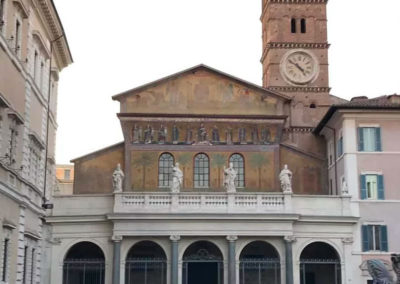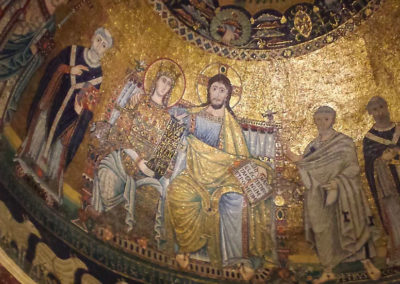S. Maria in Trastevere is one of the top rated churches in Rome.
The basilica was first built in the IV c. by Pope Giulio I, completely rebuilt in the XII c. by Pope Innocenzo II and restored several times during the following centuries.
The facade is decorated with a frieze in mosaic representing ten Vergins taking oil lamps to the Virgin Mary suckling Jesus.
The Ten Virgins are the wise ones ready to serve the Church (Mat. XXV, 1-13).
If you take a closer look to the scene you will notice that only few oil lamps are lit, instead of the all of them.
A inappropriate renovation of the mosaic led to a poor rendering of the original composition with all the lamps lit according to the Parable of St. Matthew.
The representation refers to the legend of the ‘fons olei’ that in 33 bC overflowed from the underground to announce the coming of the Saviour as the Lord’s anointed.
Above the porch designed by Carlo Fontana are the gigantic statues of the Saints strictly related to the foundation of the church: st. Callisto, st. Calepodio, st. Cornelio and st. Giulio After crossing the porch where several inscriptions from the Christian Catacombs had been fixed, you enter the basilica.
The XII c. basilica built by Innocent the 12th is perfectly balance according to the classical architectural style, therefore the central aisle is two time larger than the side ones and the columns are all recycled from the same archeological site, the Bath of Caracalla.
The most important work from this period is the mosaic decorating the apse realised in 1138, when the church was completely rebuilt and representing Jesus and the crowned Virgin Mary sitting in a throne and flanked by Saints and Popes.
Jesus holds a open book reporting ”Seat close by me, my beloved. Let’s share this throne” and the Virgin has got a scroll where you can read “He soflty places the crown in my head and tenderly embraces me with his right arm”.
The two written sentences are from the Canticle of Canticles and are strictly related to the festival of the Assumption of the Virgin, when the people used to recitate this Canticle comparing the couple to David and the queen of Saba.
It’s not for the beauty and the fineness only that this mosaic is very famous, but for the very particular iconography strongly related to the story of the scisma between two popes: Innocent II and Anacletus II, who had been simultaneously and separately elected by the two rival parties headed by the wealthiest roman families.
The double election led to a harsh struggle between the parties and Innocent II, impeded by the influential supporters of Anancleto II, fleed to Germany and France to have the help of the Emperor and of St. Bernard, the founder of the Cistercian order.
Thanks to the help of his supporters and to the death of Anacletus II, Innocent II had his power back and to celebrate his victory over the rival and after rebuilding St. Mary in Trastevere he commissioned the representation on the apse.
The mosaic showing a North European subject, particularly popular in France, brings out the renovated alliance between the Church, symbolized by the Virgin Mary, and Jesus, a union interrupted by the scisma of the Roman Church. It was thanks to Innocent II that the Church moved back to his legitimate throne and power, close to the Savior.
As the Pierleoni, the main supporters of Anacleto II, used to live close to St. Maria in Trastevere, Innocent II decided to decorate this church with something that could celebrate his victory and punish his rivals.
S. Maria in Trastevere is one of the top rated churches in Rome.
The basilica was first built in the IV c. by Pope Giulio I, completely rebuilt in the XII c. by Pope Innocenzo II and restored several times during the following centuries.
The facade is decorated with a frieze in mosaic representing ten Vergins taking oil lamps to the Virgin Mary suckling Jesus. The Ten Virgins are the wise ones ready to serve the Church (Mat. XXV, 1-13).
If you take a closer look to the scene you will notice that only few oil lamps are lit, instead of the all of them.
A inappropriate renovation of the mosaic led to a poor rendering of the original composition with all the lamps lit according to the Parable of St. Matthew.
The representation refers to the legend of the ‘fons olei’ that in 33 bC overflowed from the underground to announce the coming of the Saviour as the Lord’s anointed.
Above the porch designed by Carlo Fontana are the gigantic statues of the Saints strictly related to the foundation of the church: st. Callisto, st. Calepodio, st. Cornelio and st. Giulio After crossing the porch where several inscriptions from the Christian Catacombs had been fixed, you enter the basilica.
The XII c. basilica built by Innocent the 12th is perfectly balance according to the classical architectural style, therefore the central aisle is two time larger than the side ones and the columns are all recycled from the same archeological site, the Bath of Caracalla.
The most important work from this period is the mosaic decorating the apse realised in 1138, when the church was completely rebuilt and representing Jesus and the crowned Virgin Mary sitting in a throne and flanked by Saints and Popes.
Jesus holds a open book reporting ”Seat close by me, my beloved.
Let’s share this throne” and the Virgin has got a scroll where you can read “He soflty places the crown in my head and tenderly embraces me with his right arm”.
The two written sentences are from the Canticle of Canticles and are strictly related to the festival of the Assumption of the Virgin, when the people used to recitate this Canticle comparing the couple to David and the queen of Saba.
It’s not for the beauty and the fineness only that this mosaic is very famous, but for the very particular iconography strongly related to the story of the scisma between two popes: Innocent II and Anacletus II, who had been simultaneously and separately elected by the two rival parties headed by the wealthiest roman families.
The double election led to a harsh struggle between the parties and Innocent II, impeded by the influential supporters of Anancleto II, fleed to Germany and France to have the help of the Emperor and of St. Bernard, the founder of the Cistercian order.
Thanks to the help of his supporters and to the death of Anacletus II, Innocent II had his power back and to celebrate his victory over the rival and after rebuilding St. Mary in Trastevere he commissioned the representation on the apse.
The mosaic showing a North European subject, particularly popular in France, brings out the renovated alliance between the Church, symbolized by the Virgin Mary, and Jesus, a union interrupted by the scisma of the Roman Church. It was thanks to Innocent II that the Church moved back to his legitimate throne and power, close to the Savior.
As the Pierleoni, the main supporters of Anacleto II, used to live close to St. Maria in Trastevere, Innocent II decided to decorate this church with something that could celebrate his victory and punish his rivals.
In closing we might assume that the Wise Virgins with the oil lamps represented in the facade are simultaneously the symbol of the finding of the lost alliance between the Church and Jesus and the legend of the ‘fons olei’.
In closing we might assume that the Wise Virgins with the oil lamps represented in the facade are simultaneously the symbol of the finding of the lost alliance between the Church and Jesus and the legend of the ‘fons olei’.






